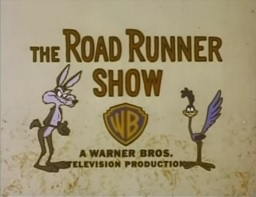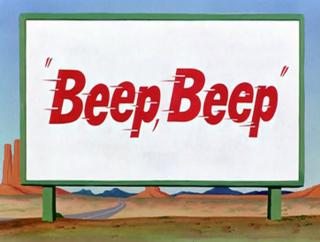
What's Opera, Doc? is a 1957 American Warner Bros. Merrie Melodies cartoon directed by Chuck Jones and written by Michael Maltese. The short was released on July 6, 1957, and stars Bugs Bunny and Elmer Fudd.

Wile E. Coyote and the Road Runner are a duo of cartoon characters from the Looney Tunes and Merrie Melodies series of animated cartoons, first appearing in 1949 in the theatrical short Fast and Furry-ous. In each film, the cunning, devious and constantly hungry coyote repeatedly attempts to catch and eat the roadrunner, but is humorously unsuccessful. Instead of using animal instinct, the coyote deploys absurdly complex contraptions to try to catch his prey. They comically backfire, with the coyote invariably getting injured in slapstick fashion. Many of the items for these contrivances are mail-ordered from a variety of companies implied to be part of the Acme Corporation. TV Guide included Wile E. Coyote in its 2013 list of "The 60 Nastiest Villains of All Time".

The Big Snooze is a 1946 Warner Bros. Looney Tunes cartoon planned by Bob Clampett and finished by Arthur Davis, who were both uncredited as directors. It features Bugs Bunny and Elmer Fudd, voiced by Mel Blanc and Arthur Q. Bryan.

Fast and Furry-ous is a 1949 Warner Bros. Looney Tunes cartoon, directed by Chuck Jones and written by Michael Maltese. The short was released on September 17, 1949, and stars Wile E. Coyote and the Road Runner, in their debut.

The Bugs Bunny/Road Runner Movie is a 1979 American animated comedy package film directed by Chuck Jones, consisting of a compilation of classic Looney Tunes/Merrie Melodies shorts and newly animated bridging sequences hosted by Bugs Bunny. The bridging sequences, which had been produced in 1978, show Bugs at his home, which is cantilevered over a carrot-juice waterfall. The film was released to celebrate the 40th anniversary of Bugs Bunny.

The Road Runner Show is an American Saturday morning animated anthology series which compiled theatrical Wile E. Coyote and the Road Runner cartoons from the Looney Tunes and Merrie Melodies, which were produced by Warner Bros. Cartoons between 1949 and 1964. Several of the shorts, especially the ones produced from 1965 onward, were produced by DePatie–Freleng Enterprises after Warner Bros. closed their animation studio. DePatie–Freleng Enterprises provided the animation for the show's intro, closing credits as well as the wrap-around bumpers.

Kids' WB Fun Zone is a themed attraction in Warner Bros. Movie World on the Gold Coast, Queensland, Australia based on the Looney Tunes cartoons. The attraction was originally named Looney Tunes Village and was renamed in late 2007 when two new rides were added. At the same time, the Australian Kids' WB TV show began filming at the theme park. Two similar themed attractions, Looney Tunes Land and Cartoon Village, opened at Warner Bros. Movie World Germany in Bottrop Kirchhellen, Germany in 1996 and Parque Warner Madrid in Madrid, Spain in 2002, respectively, with the latter remaining to this day.

Beep, Beep is a 1952 Warner Bros. Merrie Melodies series directed by Chuck Jones. The short was released on May 24, 1952, and is the second featuring Wile E. Coyote and the Road Runner. The cartoon is named after the sound the Road Runner makes, which is also known as "Meep, meep".

Guided Muscle is a 1955 Warner Bros. Looney Tunes cartoon directed by Chuck Jones. The short was released on December 10, 1955, and stars Wile E. Coyote and the Road Runner.

Scrambled Aches is a 1957 Warner Bros. Looney Tunes cartoon directed by Chuck Jones. The short was released on January 26, 1957, and stars Wile E. Coyote and the Road Runner. The title is a pun on scrambled eggs.
The Bugs Bunny Mystery Special is an animated television special that was broadcast on CBS October 15, 1980. Presented by Porky Pig as an Alfred Hitchcock-style whodunit, the plot is modeled after those of North by Northwest and The Fugitive.

The Hare-Brained Hypnotist is a Warner Bros. Merrie Melodies cartoon directed by Friz Freleng. The short was released on October 23, 1942 and features Bugs Bunny and Elmer Fudd. This cartoon's plot was re-worked for the cartoon Hare Brush (1955) and its opening music was re-used in Hair-Raising Hare (1946), The Super Snooper (1952) and Hyde and Hare (1955).
Zoom at the Top is a 1962 Merrie Melodies cartoon directed by Chuck Jones and designer Maurice Noble. The short was released on June 30, 1962, and stars Wile E. Coyote and the Road Runner.

Gee Whiz-z-z-z-z-z-z is a 1956 Warner Bros. Looney Tunes cartoon directed by Chuck Jones. The short was released on May 5, 1956, and stars Wile E. Coyote and the Road Runner.

Bugs Bunny's Bustin' Out All Over is a springtime-themed Looney Tunes animated television special which aired on CBS on May 21, 1980.
Zip 'n' Snort is a 1961 Warner Bros. Merrie Melodies cartoon directed by Chuck Jones. The short was released on January 21, 1961, and stars Wile E. Coyote and the Road Runner.

Soup or Sonic is an animated cartoon in the Merrie Melodies series, starring Wile E. Coyote and the Road Runner. It was first aired May 21, 1980 on CBS as part of the television special Bugs Bunny's Bustin' Out All Over and was one of three new cartoons released. This is the only canonical cartoon in which Wile E. Coyote catches the Road Runner without him escaping afterward, although due to the existing circumstances, Wile E. is physically unable to actually eat the Road Runner.

Hare-Breadth Hurry is a 1963 Warner Bros. Looney Tunes cartoon directed by Chuck Jones and Maurice Noble. The cartoon was released on June 8, 1963, and stars Bugs Bunny and Wile E. Coyote.
Rushing Roulette is a 1965 Warner Bros. Merrie Melodies cartoon directed by Robert McKimson. The short was released on July 31, 1965, and stars Wile E. Coyote and the Road Runner. It was the second Road Runner cartoon directed by someone other than Chuck Jones, who had almost exclusively used the characters since their debut in 1949. McKimson directed one other Road Runner cartoon the following year, Sugar and Spies.
Clippety Clobbered is a 1966 Warner Bros. Looney Tunes theatrical animated short directed by Rudy Larriva. The short was released on March 12, 1966, and stars Wile E. Coyote and the Road Runner.















